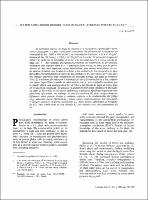| dc.contributor.author | Klar, A.E. | |
| dc.date.accessioned | 2022-12-15T23:59:27Z | |
| dc.date.available | 2022-12-15T23:59:27Z | |
| dc.date.issued | 1981-10 | |
| dc.identifier.uri | https://repositorio.catie.ac.cr/handle/11554/12208 | |
| dc.description.abstract | Se cultivaron plantas de papa en macetas y se sometieron a potenciales decrecientes suelo/agua (r ) bajo condiciones controladas. Se aplicaron dos tratamientos de intensidad de luz: 1000 y 400 uE/m2s, dos humedades absolutas: 9.30 y 15.40 glm3 durante el día (16 horas), y 9.64 y 11.79 gima en la noche. El potencial de agua del follaje (Ψ) varió con la intensidad de la luz y la humedad del aire y estuvo correlacionado con r. Sin embargo, las plantas provenientes del tratamiento de aire húmedo mostraron una relación entre Ψ y r siguiendo líneas rectas, en tanto que las provenientes de aire seco siguieron curvas hiperbólicas, para ambas intensidades de luz: las últimas tuvieron una tendencia a llegar a los umbrales de los potenciales de agua del follaje correspondientes al cierre de los estomas (Ψ th) con valores de r más altos que cuando estuvieron bajo condiciones de humedad elevada. Las tasas de transpiración (E) resultaron afectadas por la humedad del aire y la intensidad de la luz, y siguieron curvas hiperbólicas cuando se relacionaron con Ψ. Los resultados muestran que se puede aplicar una analogía de la ley de Ohm a las plantas de papa, al menos bajo las condiciones estudiadas. En general, las plantas jóvenes (fase vegetativa) y las maduras (fase de floración; no mostraron diferencias estadísticas significativas para las comparaciones efectuadas; sin embargo, la tasa fotosintética (P) tuvo comportamientos diferentes entre plantas jóvenes y maduras respecto a la conductividad del follaje (Kc), siguiendo curvas hiperbólicas y líneas rectas, respectivamente; por otra parte, P siempre aumentó conforme incrementó K. Hubo fuertes diferencias en el ingreso de CO2 bajo condiciones de una elevada Kc con relación a los dos tratamientos de luz. | es_ES |
| dc.description.abstract | Potato plants were grown in pots and subjected to decreasing soil/water potentials (r ) under controlled conditions. Two light intensity treatments were applied: 1000 and 400 uE/m2s, two absolute humidities: 9.30 and 15.40 glm3 during the day (16 hours), and 9.64 and 11.79 gima at night. Foliage water potential (Ψ) varied with light intensity and air humidity and was correlated with r. However, plants from the humid air treatment showed a relationship between Ψ and r following straight lines, whereas those from dry air followed hyperbolic curves, for both light intensities: the latter had a tendency to reach foliage water potential thresholds corresponding to stomata closure (Ψ th) with higher r values than when under high humidity conditions. Transpiration rates (E) were found to be affected by air humidity and light intensity, and followed hyperbolic curves when related to Ψ. The results show that an analogy of Ohm's law can be applied to potato plants, at least under the conditions studied. In general, young (vegetative phase) and mature (flowering phase) plants showed no significant statistical differences for the comparisons made; however, photosynthetic rate (P) behaved differently between young and mature plants with respect to canopy conductance (Kc), following hyperbolic curves and straight lines, respectively; on the other hand, P always increased as K increased. There were strong differences in CO2 influx under high Kc conditions in relation to the two light treatments. | es_ES |
| dc.format.extent | 8 páginas | es_ES |
| dc.language.iso | en | es_ES |
| dc.publisher | Instituto Interamericano de Cooperación para la Agricultura (IICA) | es_ES |
| dc.relation.ispartof | Turrialba; Vol. 31, no. 4 | es_ES |
| dc.subject | SOLANUM | es_ES |
| dc.subject | ESTRES DE SEQUIA | es_ES |
| dc.subject | CONTENIDO DE HUMEDAD | es_ES |
| dc.subject | REGIMENES DE LUZ | es_ES |
| dc.subject | ESTOMA | es_ES |
| dc.subject | TRANSPIRACION | es_ES |
| dc.subject | FISIOLOGIA VEGETAL | es_ES |
| dc.subject | RESPUESTA DE LA PLANTA | es_ES |
| dc.subject | SOLANUM | es_ES |
| dc.subject | DROUGHT STRESS | es_ES |
| dc.subject | MOISTURE CONTENT | es_ES |
| dc.subject | LIGHT REGIMES | es_ES |
| dc.subject | STOMATA | es_ES |
| dc.subject | TRANSPIRATION | es_ES |
| dc.subject | PLANT PHYSIOLOGY | es_ES |
| dc.subject | PLANT RESPONSE | es_ES |
| dc.subject.other | Sede Central | es_ES |
| dc.title | Flujo de agua y COsub-índice 2 en plantas de papa sometidos a falta de agua | es_ES |
| dc.title.alternative | Water and carbon dioxide flux in water-stressed potato plants. | es_ES |
| dc.type | Artículo | es_ES |
| dc.identifier.status | openAccess | es_ES |


